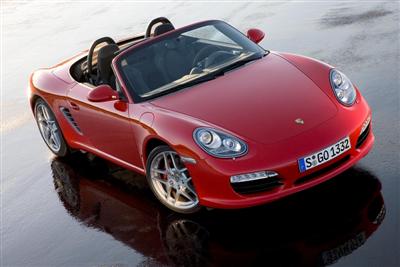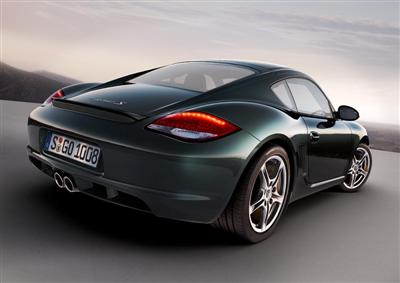|
| ||||
|
New Porsche Boxster & Cayman Revealed In Los Angeles
24th November, 2008 | |||
|
The new Porsche Cayman and Boxster revealed in recent days at the Los Angeles Motor Show continue Porsche’s push towards greater sports car efficiency. All new engines, more power, the introduction of Porsche’s double clutch gearbox Doppelkupplungsgetriebe (PDK for short) and improved fuel economy are the technical highlights of the new models. Newly developed boxer engines offer more power on less fuel 
Now displacing 2.9 litres, the flat six cylinder engine develops 188 kW in the entry level Boxster and 195 kW in the entry level Cayman, an increase by 8 kW and 15 kW respectively over the preceding models with their 2.7-litre engine. The 3.4-litre engine in the 'S' versions, benefiting from Direct Fuel Injection, now delivers 228 kW in the Boxster S and 235 kW in the Cayman S, up 11 kW and 18 kW respectively. These power gains, combined with an outstanding power-to-weight ratio, deliver maximum driving dynamics on minimum fuel. As a result, the 3.4 litre Cayman S with optional PDK and optional Sports Chrono Package (featuring Launch Control) now accelerates to 100 km/h in 4.9 seconds to set the benchmark for the mid-engined range. The 2.9-litre Boxster with its six-speed manual gearbox featured as standard completes the same sprint in 5.9 seconds. With optional PDK, both the 2.9-litre Boxster and 2.9-litre Cayman models better the nine-litre/100 kilometres consumption mark for the first time – recording 8.9 litres/100 kilometres according to the EU4 standard. This is an 11 per cent improvement over the former models with Tiptronic S gearbox. Even greater fuel savings are recorded with the 3.4 litre Boxster S and Cayman S with optional PDK. Their fuel consumption of 9.2 litres/100 kilometres represents a significant reduction of 16 per cent over the previous models with Tiptronic S. Roadster and Coupé with even more signs of distinction The new two seater models are clearly identified on the exterior through their newly designed front and rear styling. The new halogen headlights with their integrated indicators are reminiscent of the headlights on the Carrera GT, while the new LED rear lights taper to the outside and integrate elegantly into the rear body work. At the front the Roadster and Coupé differ clearly from one another through the distinctive design of their air intakes; from the rear through the new rear panels with diffuser inserts on the Boxster and a wind deflector plate on the Cayman. Yet a further highlight is provided by the fog lamps featured as standard – rectangular in shape on the Boxster, round on the Cayman. For the first time both models are available with an optional Lights Package featuring bi-xenon headlights, dynamic curve lights and LED daytime driving lights. Replacing the fog lamps, these light units are made up on the Boxster of four LEDs positioned next to one another, while on the Cayman four LEDs are arranged in round light units. PDK: shifting gears quicker, reducing fuel consumption by up to 16 per cent All four mid-engined sports cars are available for the first time with the optional Porsche Doppelkupplungsgetriebe, or PDK for short, carried over directly from motor sport and replacing the former Tiptronic S. Equipped with the PDK double clutch gearbox, the Roadster and Coupé accelerate from 0–100 km/h in a time 0.1 seconds faster than the standard six-speed manual gearbox. The optional Sports Chrono Package (featuring Launch Control and race track style gear shifting) improves the 0–100 km/h sprint by a further 0.2 seconds. Porsche has produced a unique ‘win-win’ situation: not only does PDK offer faster gear shifts and superior performance, but fuel consumption is also reduced by up to 16 per cent. Dynamic suspension and supreme brakes The suspension with its new set-up gives the new models a combination of even greater driving dynamics and enhanced comfort all in one. Modification of the valve control map on the steering serves furthermore to reduce steering forces, giving the Boxster and Cayman even more agile and spontaneous steering behaviour. 
The wheels come in a new design and are a half-inch wider on the 2.9 litre models than in the past in order to accommodate the larger front brakes of the 3.4 litre 'S' models. Both the Boxster and Cayman feature the latest generation of PSM Porsche Stability Management now offering two new functions: Brake Pre-Loading and the Brake Assistant. Whenever the driver lets go of the accelerator pedal very quickly – which is typical of an upcoming emergency braking manoeuvre – the PSM hydraulic control unit builds up an appropriate level of pressure on the wheel brakes before the driver even presses the brake pedal, moving the brake pads slightly towards the discs for immediate action. This significantly improves brake response and shortens stopping distances accordingly. When recognising that the driver is braking in an emergency due to very fast operation of the brake pedal and a defined brake force, the PSM hydraulic control unit actively delivers the brake pressure required for maximum stopping power. Last but not least, Porsche’s new two seaters are available as an option with seat ventilation combined with seat heating. The new models will enter the Australian market in late March 2009, with final specification and pricing to be confirmed closer to their launch date. | ||||
ABN 47106248033 |
 |
All rights reserved. |

